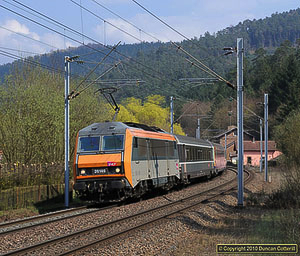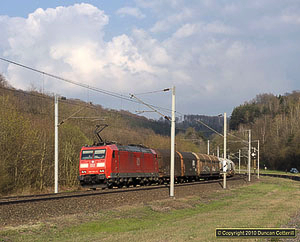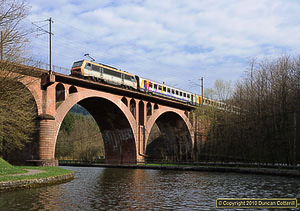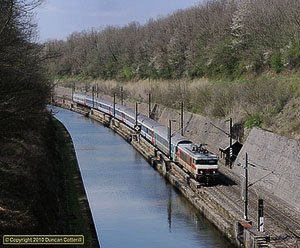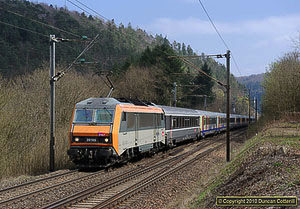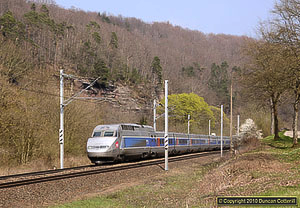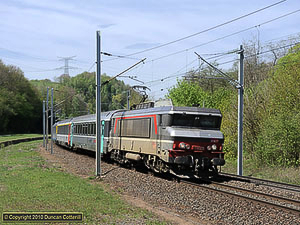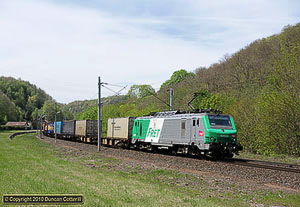Saverne Gap
15-16 & 29 April 2010
Report by Duncan Cotterill
Introduction
I spent a day and a half on this interesting line in eastern France on my way to Germany, on 15-16 April 2010, and half a day on my way back on 29 April 2010.
This report is divided into two parts: This page contains a summary of the trip. The
Day by Day section contains details of each day’s activities, trains seen, travel, hotels etc.
The Saverne Gap
The Saverne Gap provides a relatively easy route through the Vosges for the Paris - Nancy - Strasbourg - Offenburg and Luxembourg - Metz - Strasbourg - Basel main lines, which join at Reding, near Sarrebourg. The combined double-track line, electrified at 25kV, soon meets and then runs alongside the Rhine - Marne canal in a deep cutting that ends at the west end of the Arzviller tunnel. The canal runs through a parallel tunnel and, 1.5km later, both railway and canal emerge into the valley of the river Zorn, just below the village of Arzviller. For the next 15km, the railway and canal follow the twisting Zorn valley down to Saverne where they emerge from the forested hills into the rolling farmland of Alsace.
Passenger Trains
There’s a good variety of motive power on the passenger trains that run through the Saverne Gap. The majority of long distance trains are TGVs, running over the LGV Est from the Paris area to Baudrecourt, where they join the Metz - Strasbourg main line. As well as frequent Paris - Strasbourg TGVs, there are also trains from Paris to Stuttgart, München, Basel and Zürich and from Strasbourg to Lille, Bordeaux, Nantes and Rennes. The only loco hauled long distance services are three pairs of trains between Brussels and Zürich via Luxembourg, Metz, Strasbourg and Basel, formed of conventional stock and hauled across France by class BB15000 locos. All the other passenger trains are classed as TERs or TER200s. All the TER200s and some of the TERs are worked by class BB26000 locos on push-pull sets, usually of eight coaches or more. The loco is always at the west end of the stock, i.e. leading on trains from Strasbourg. The remaining TERs, generally those in the middle of the day, are worked by a mixture of Z11500 and AGC units.
The passenger timetable is a work of immense complexity and about as far from regular interval as it’s possible to be. Every single day appears to have a slightly different pattern of trains, for no apparent reason. I had to spend several days on Hafas, working out what was supposed to run on each of the days I was there. Then it turned out there was a strike and it was possible that nothing would run at all. Fortunately that wasn’t the case and every train I expected turned up. Just as well or I would have been very annoyed.
Freight Trains
While the passenger timetable is complex, the freight timetable seemed to be extremely simple. Freights would only run when it was cloudy. After two days, I only had one shot of a freight in good light and that was hauled by a DB class 185. Traffic levels were reasonable, although nothing like as heavy as expected, maybe one freight each way every two hours or so on average. The only discernible pattern was that eastbounds were rare in the late morning when the light was best for eastbounds and westbounds were rare in the afternoon when the light was best for westbounds. There were some very long gaps at times, particularly on the first two days, although 29 April was noticeably busier.
Freight motive power was quite varied. SNCF BB27000 and BB37000 predominated but there were also several DB 185s and SNCB 13s, a BB26000, a Europorte2 Vossloh G1500 (or similar) and an ECR 66.
Photography
I found the line a bit more difficult to photograph than expected. For most of its length, the route is fairly overgrown although there were a few clear spots, notably around the closed stations at Stambach and Arzviller and at the west end of the Arzviller Tunnel. Most spots were better suited to afternoon photography and, with the locos on the west end of the TER sets, it could be a bit difficult finding suitable locations for the trains on offer in the early morning. By late morning, the positions around the closed Arzviller station and the tunnel were well lit.
One problem I didn’t anticipate was that the electrification masts appear to be much more closely spaced than is the norm in Germany and it was difficult to find positions where the locos could be photographed without poles growing out of the top.
The line is paralleled by a good, and fairly quiet, road all the way from Saverne to the Arzviller Tunnel and there are also parallel forest tracks, not to mention the canal towpath, for those on foot or pushbike. Most of the good locations are within 5 or 6 km of Lutzelbourg, which has an open station and decent hotel, so arriving by train and doing the line on foot would be practical. The west end of the Arzviller tunnel is about 8 km from Lutzelbourg and about as far as you would need to go. Public transport is of very limited use. The local train service is pretty sparse, most intermediate stations have been closed and local buses appear to be very few and far between.
Comments
An interesting stopover on the long drive from the UK to southern Germany. The Zorn Valley is very attractive and the presence of the canal adds to the interest but, having heard so much about the Saverne Gap, I was a little disappointed that there weren’t more good locations and more freight trains. Traffic levels are reasonable, particularly if you don’t mind photographing the odd unit or TGV, and there’s plenty of motive power variety. The BB15000s on the Zürich - Bruxelles trains and the Sybics on long TER rakes make particularly good pictures and although the BB27000s and BB37000s aren’t the most attractive engines, they could be far worse. I’ll certainly be calling in again in the future.
This report is divided into two parts: This page contains a summary of the trip. The Day by Day section contains details of each day’s activities, trains seen, travel, hotels etc.
